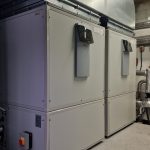Do heat pumps work with radiators?
Heat pumps are an efficient and eco-friendly heating solution that has become increasingly popular in recent years. However, many building managers with traditional radiator heating systems may be hesitant to make the switch to a heat pump, wondering whether or not heat pumps work with radiators. In this article, we will explore how heat pumps work with radiators and whether or not they are a viable option with radiator heating systems.
First, it’s important to understand how heat pumps work. A heat pump works by extracting heat from the air outside and transferring it into your building to keep it warm.
Secondly, it’s important to understand how radiators work. Radiators work by simply sending hot water through them, the hot water heats up the columns of the radiator which then radiates heat out into the room. However, the temperature that is going into the radiator and the size of the radiator itself make a significant difference to the heat output of the radiator. If we put hotter water through the radiator the output will be more. Likewise, if the radiator is much larger the output is also greater as there is a larger surface area of heat. This happens without having to increase the temperature of the water going into the radiator.
One of the main concerns with radiator heating systems for property owners is whether or not heat pumps can work with their existing radiators. The short answer is yes, heat pumps can work with radiators. However, it is important to note that there are two different types of heat pumps that can work with radiators, but they may not work that well with your existing radiators. Standard heat pumps work with a flow temperature of 55°C. You can also get high-temperature heat pumps which can give a flow temperature as high as 70-75°C. Now it is most likely that an existing radiator system was designed to work with a flow temperature of 80°C as this is the standard flow temperature of a gas or oil boiler.
What this means is, if you replace your boiler with a standard air to water heat pump with a flow of 55°, it will work but the radiators wont get so hot. So when it gets really cold outside, your room wont get warm. So the existing radiators will have to be replaced for radiators that are slightly bigger, or install additional radiators to the system, to make up for the drop in flow temperature. With a high temperature air-to-water heat pump, although the flow temperature is often 5°C or so less than the 80°C required, it is usually still enough to get your room up to a comfortable temperature without having to replace the existing radiators.
In addition to working with radiators, heat pumps offer several other benefits over traditional heating systems. For one, they are more energy-efficient, which can result in cost savings on your energy bills. They are also more eco-friendly, as they use renewable energy sources to provide heat, rather than relying on fossil fuels.
In conclusion, heat pumps can work with radiators and are a great heating solution to make buildings energy-efficient and eco-friendly. If you’re interested in installing a heat pump, be sure to consult with a professional HVAC technician to determine the best type of heat pump for your specific heating needs. With the right heat pump and proper installation, you can enjoy a warm and comfortable building all winter long while reducing your environmental impact and energy costs.






